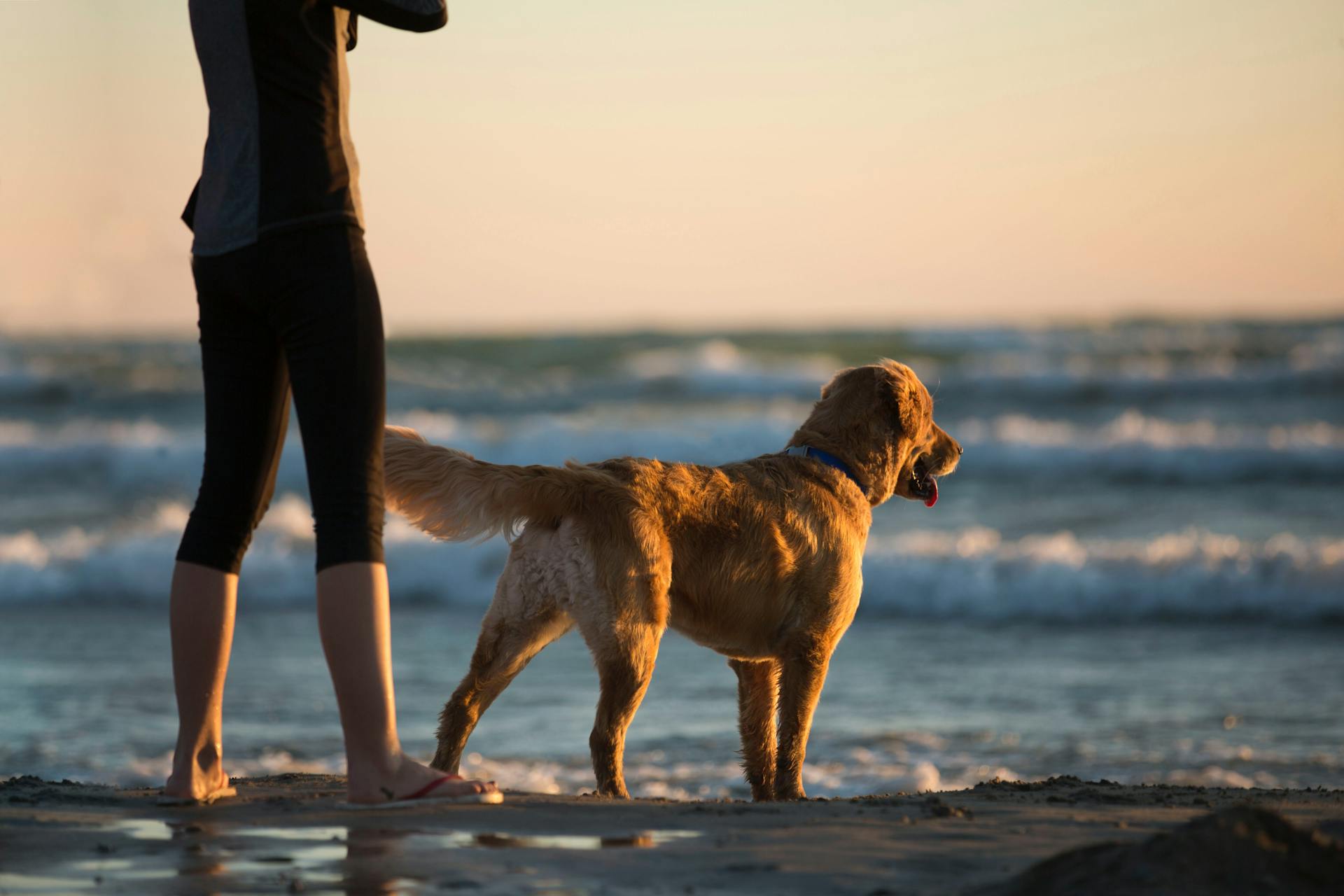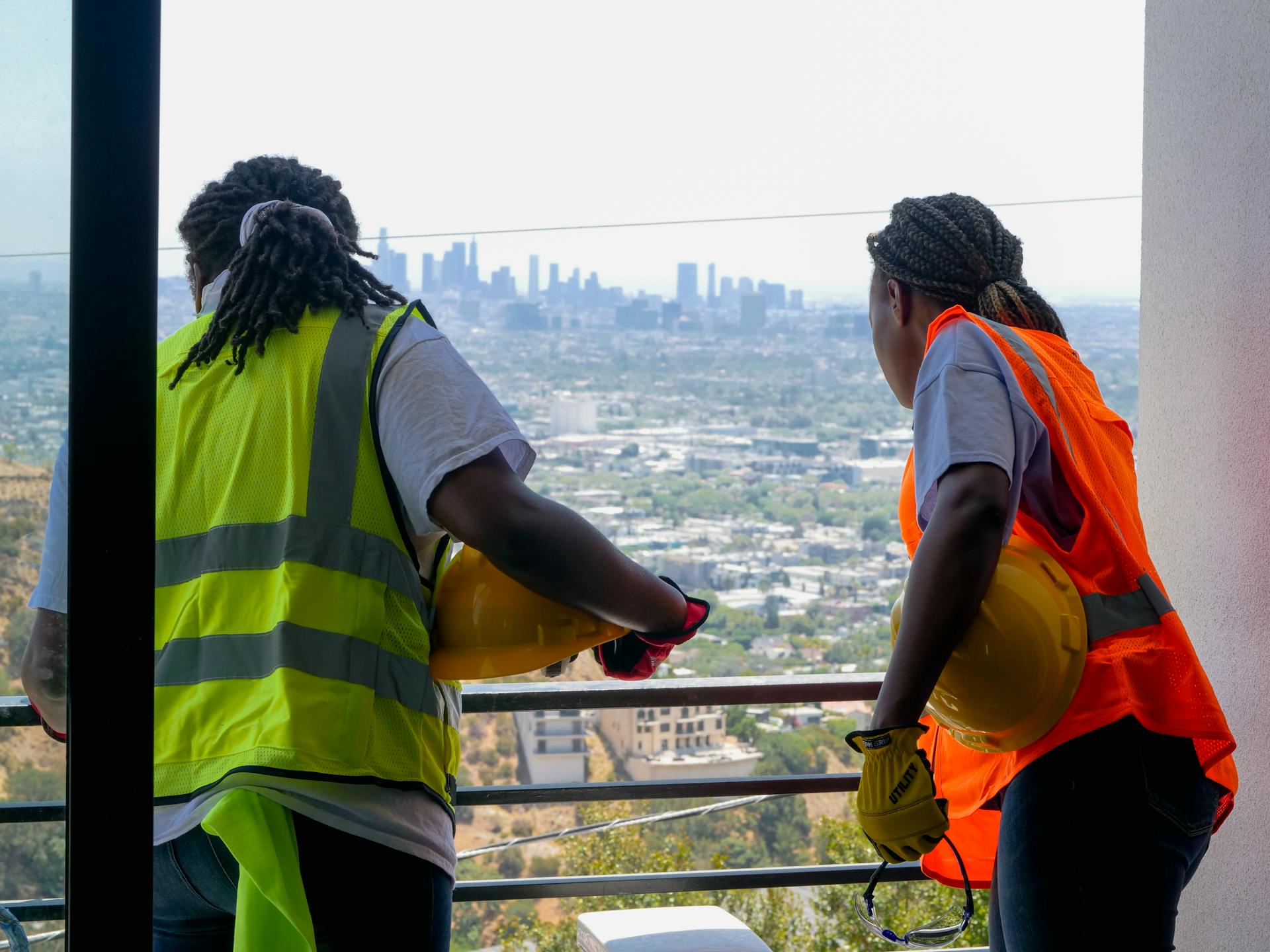
Creating a secure outdoor space for your furry friend is a top priority. Make sure your balcony railing is at least 4 feet tall to prevent your dog from jumping over.
A sturdy railing is just the beginning. You should also install a non-slip surface on your balcony floor to prevent your dog from slipping and falling.
Regularly inspect your balcony for any hazards, such as loose boards or sharp edges. This will help prevent accidents and ensure your dog's safety.
By following these simple tips, you can create a safe and enjoyable outdoor space for your dog to relax and play.
Understanding Risks
Dogs can fall off balconies, resulting in severe injuries or even death. This is a significant risk, especially if the balcony is high.
Falling is the primary balcony hazard for pets, and it can cause a range of injuries, including broken bones, skin abrasions, and damage to internal organs. Dogs can also suffer soft-tissue sprains and facial injuries like trauma to the nose and teeth, split palates, and broken jaws.
Dogs can get their heads or paws stuck in the balcony railings, leading to injuries or suffocation. This is a common risk, especially if the railings are too wide.
To prevent these risks, it's essential to take the necessary precautions. Here are some common balcony risks for dogs:
- Falling
- Jumping
- Getting stuck
- Ingesting toxic substances
These risks can be prevented by taking a few simple precautions, such as installing a safety net or gate, checking the balcony railings, keeping toxic substances out of reach, and supervising dogs on the balcony.
Essential Measures
Securing railing gaps is crucial to prevent your dog from slipping through and falling. This can be achieved by installing safety screens or mesh panels to fill the gaps between the railing and the wall.
Using sturdy balustrade materials is essential for withstanding the weight of your dog. Look for materials that are specifically designed for outdoor use and can withstand harsh weather conditions.
Installing non-slip flooring on your balcony is a must to prevent your dog from slipping and falling. This can be achieved by using textured or rubberized flooring that provides traction and grip.
Protective Barriers
Protective barriers are a must-have for any dog owner who wants to ensure their furry friend's safety on the balcony. They come in various forms, including protective screens made of durable materials like metal or plastic.
To choose the right protective screen, consider your dog's size and adjustability is a key feature to look for. Adjustable screens can be tailored to fit balconies of different sizes, making them a versatile option.
Some protective screens are designed to be attached to the balcony railing, creating a barrier that prevents dogs from falling off. Others can be installed as a net to cover the entire balcony area, providing maximum safety for larger dogs.
For smaller dogs, a lattice fence can be a suitable option, but be aware that there are gaps in the lattice that can be large enough for small dogs to fit through. A well-made lattice fence looks elegant and can be purchased ready-made or DIY, but it's essential to check the cable ties daily for wear and tear.
Here are some key features to consider when choosing a protective barrier:
- Adjustability for different balcony sizes
- Durable materials like metal or plastic
- Ability to attach to balcony railing
- Netting or lattice design for maximum safety
- Easy installation and maintenance
Remember, the gap between railings should be no more than 4 inches apart to prevent your dog from slipping through or getting stuck. Regularly check the railings for any safety issues, such as cracking plexiglass or broken bars.
Dog Training and Behavior
Training your dog for balcony safety is crucial to prevent accidents. Training them properly can be a game-changer.
To start, training your dog for balcony safety involves teaching them to stay away from the balcony railing. This can be done by placing a barrier, such as a baby gate, at the balcony entrance to block their access.
A well-trained dog will learn to associate the balcony with a no-go zone, reducing the likelihood of accidents.
Discover more: All about Dogs Dog Training
Training Your Dog
Training your dog requires patience and consistency. Start with short training sessions to keep them engaged.
Housebreaking is a crucial aspect of dog training. It's essential to establish a routine and stick to it.
Positive reinforcement techniques work wonders in dog training. Rewarding good behavior with treats and praise encourages desired actions.
Training your dog for balcony safety is also vital. It's essential to train them properly to prevent any accidents.
Socialization is key to well-behaved dogs. Expose them to various environments, people, and other animals to help them develop good social skills.
Consistency is key when training your dog. Use the same commands and hand signals to avoid confusion.
Collar Bumpers
Collar Bumpers are a great solution for keeping your dog safe on the balcony. They're inexpensive.
You can attach a Collar Bumper to your dog's neck with a Velcro strap or fasten it to their collar. This makes it easy to use.
Collar Bumpers are a good choice for all dogs, regardless of size or breed. They're a simple way to prevent your dog from putting their head through the balcony railing bars.
Here are some benefits of using Collar Bumpers:
- Inexpensive
- Suits all dogs
- Easy to use
Just keep in mind that your dog may feel uncomfortable if you leave them in a Collar Bumper for long periods.
Environmental Safety
Creating a safe balcony environment is crucial for your dog's well-being. Here are some essential tips to ensure your furry friend stays safe while enjoying the balcony.
First and foremost, secure your balcony railing to prevent your dog from accidentally falling off. A sturdy railing will give you peace of mind while your dog is out on the balcony.
Make sure your balcony is free from any hazards such as loose furniture or sharp objects that could harm your dog. Regularly inspect your balcony to ensure it remains dog-friendly.
Worth a look: Is It Safe to Take Dogs to the Dog Park
Cats and Balcony Falls
Cats are more prone to jumping onto and over balcony railings, making them more likely to fall.
Both cats and dogs can squeeze through balcony railings, but cats are more likely to suffer serious injuries from falls.
About 97 percent of cats who have fallen from high rises survive, but many sustain serious injuries, including fractured limbs.
In one report, 46 percent of cats who fell from high rises presented with fractured limbs.
A one-story fall can sometimes cause injuries, especially with dogs, who are not as agile as cats.
Even a two-story fall can be serious, despite what some people might think.
Discover more: Is High Protein Dog Food Good for Dogs
Furniture

When choosing furniture for your balcony, consider dog-friendly options to ensure your furry friend's safety.
Dog-friendly furniture is typically made of durable materials like metal or plastic.
These materials are designed to be stable and secure, making them perfect for a balcony setting.
To prevent accidents, choose furniture that is the right size for your dog, so they can't fall off or get stuck between the furniture and the railing.
By selecting the right dog-friendly furniture, you can create a safe and enjoyable outdoor space for your dog to relax and play.
Plant
Plant safety is crucial for pet owners. Some plants, like lilies, azaleas, and daffodils, can be harmful to dogs if ingested.
It's essential to choose dog-friendly plants for your balcony or indoor space. Opt for plants like marigolds, petunias, and snapdragons instead.
Keep plants out of reach of your dog to avoid any potential harm.
Outdoor Potty Spot
Creating an outdoor potty spot for your dog can be a lifesaver, especially for apartment and condo dwellers. It can be as simple as a pee pad in the balcony corner.
Just be sure the potty spot will contain your dog's business rather than allowing it to fall on the balcony below. Choose something easy to clean.
To show your dog where to do their business, teach them a potty cue while you're on your daily walks. This will help them associate the cue with the potty spot.
Your balcony shouldn't become your dog's regular toilet, and it should never be their only access to the outside world. They still need regular walks for exercise and mental stimulation.
Take a look at this: Indoor Dog Potty for Male Dogs
Avoiding Harmful Substances
Pesticides, fertilizers, and cleaning products are common household items that can be toxic to your dog, so it's essential to store them in a secure location.
Keep these substances out of reach of your dog to prevent accidental ingestion or exposure. Store them in a locked cabinet or on a high shelf where your dog cannot access them.
Avoid using chemicals on your balcony that could be harmful to your dog, as the fumes and residue can still pose a risk even if your dog isn't directly exposed to them.
By taking these precautions, you can create a safer environment for your dog to enjoy your balcony.
Frequently Asked Questions
How to make your balcony pet safe?
Secure your balcony with a tall stair gate or mesh screens to prevent pets from escaping, and always supervise them when doors are open
How to make deck railing safe for dogs?
To make deck railing safe for dogs, choose a sturdy railing material with a durable powder coating that can withstand chewing. Consult with your contractor for recommendations on the best railing material and brand for your home.
Sources
- https://blog.tryfi.com/balcony-safety-for-dogs/
- https://www.akc.org/expert-advice/home-living/making-your-balcony-fun-and-dog-friendly/
- https://www.dogster.com/dog-health-care/how-to-dog-proof-a-balcony
- https://www.petmd.com/dog/general-health/balcony-safety-and-pets-how-avoid-high-rise-risks
- https://hotdogonaleash.com/securing-your-pup-ensuring-high-balcony-safety-for-dogs/
Featured Images: pexels.com


